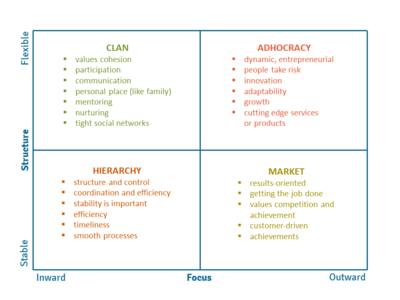Adhocracy
| Adhocracy |
|---|
| See also |
Adhocracy - involves temporary organization structure changes. The term is derived from the Latin "ad hoc", setting out the one time operation. Allows to maximize the operational flexibility through a small degree of formalization of structures. Works best in a dynamic environment, in small organizations. Concept of adhocracy was developed by Henry Mintzberg, and is often called as Mintzberg model or Mintzberg structure.
Employee behaviour in adhocracy culture
Employees working under adhocracy orient its efforts on the outside, they also are looking for contacts, procuring contractors and associates. Work is done in teams dealing with a particular task, functions and positions (including executives) are fluid. There is also a variable number of people dealing with important issues, adapted flexibly as is progresses and develops. Persons employed full-time are a small part of all those involved in the implementation of the task. Reciprocal arrangements for the principles of cooperation, substantive issues related to the implementation of tasks and division of labour, are the primary means of coordinating.
In adhocracy organizational structure, each participant is, in part task performer, coordinator and assistant. The latter function is understood as the support for management and is an important factor affecting the efficiency of the functioning of the organization.
Examples
Organizations of this nature can be found among: advertising agencies, broad media (e.g. newspapers), companies engaged in finance, marketing, but also research and development activities.
See also:
References
- Autier, F. (2001). Bureaucracy vs. Adhocracy: a case of overdramatisation?. École de management Lyon.
- Cameron, K. S., & Quinn, R. E. (2011). Diagnosing and changing organizational culture: Based on the competing values framework. John Wiley & Sons.
- Hays, S. W. (1991). From adhocracy to order: organizational design for higher education research and service. Research management review, 5(2), 1-17.
- Mintzberg, H., & McHugh, A. (1985). Strategy formation in an adhocracy. Administrative science quarterly, 160-197.
- Mintzberg, H. (1981). Organization design: fashion or fit?. Graduate School of Business Administration, Harvard University.
- McKenna, C. D. (1996). Agents of adhocracy: management consultants and the reorganization of the executive branch, 1947-1949. Business and Economic History, 25(1), 101-111.
- Waterman, R. H. (1993). Adhocracy. WW Norton & Company.
